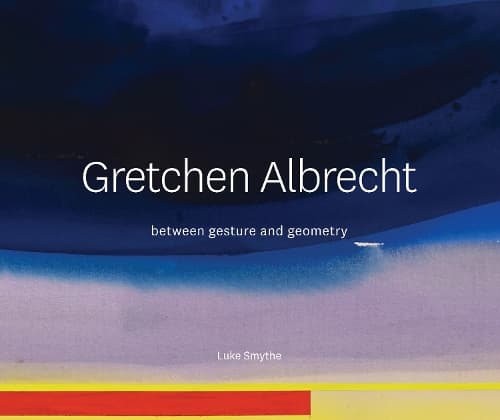Review — Gretchen Albrecht: Between gesture and geometry
Reviewed by Peter Simpson
Luke Smythe’s excellent monograph documenting the rich career of painter and print-maker Gretchen Albrecht was first published in 2019 and now appears in a revised and expanded edition just four year later. The new edition includes an additional chapter, ‘time’s measure’, covering the years 1919-23, brings the reference material (chronology, bibliography etc.) up to date and makes a few changes to illustrations (photographs, reproductions, fold-outs), especially in the later chapters; the book also has a new cover and new endpapers.
Those who follow Albrecht’s work closely and own the first edition will be faced with a dilemma as to whether or not to acquire the new edition. It is certainly a beautiful book in every respect (text, images, production) and includes enough new material to make it a thoroughly worthwhile acquisition.
Albrecht, who turns 80 this year, has had a consistently productive and successful career now stretching across six decades. She held her first solo show at Ikon Gallery in Auckland in 1964, the year after she graduated from Elam, and at the time of writing has a show of new (and some old) work at Two Rooms in Auckland, 59 years later. There is no sign of any falling away of energy or invention or quality – her new works have all the boldness of vision, technical expertise, richness of connotation and opulence of colour that we have come to expect from her.
Luke Smythe, who teaches art history and theory at Monash University in Melbourne and has also taught in New Zealand and the United States, has studied Albrecht’s work for decades and brings to it a wide knowledge of international practice in contemporary painting. This is an appropriate perspective within which to view Albrecht’s career which, while engaging with elements of local reality (‘Karekare’, ‘Piha’, ‘Whatipu’, ‘Titirangi’, ‘pohutukawa’, ‘Aotearoa’, ‘Pacific’ appear in her titles), and with elements of New Zealand art history – Frances Hodgkins, Louise Henderson, Rita Angus, Gordon Walters among others), her outlook is broadly international and universal and appeals to viewers wherever in the world they may have been exposed to it. The Irish writer Colm Tóibin, for example, is another who has written sympathetically about her work.
Smythe’s text follow’s Albrecht’s development chronologically from her early figurative drawings and paintings in the 1960s, through her drift towards abstraction in the 1970s in series focussed on gardens, skies and beaches, to the distinctive shaped abstract canvases – especially hemispheres and ovals – which dominated her practice in the 1980s and 1990s, and the more miscellaneous practice of the last two decades which has involved a return to rectangular formats as well as continuous evolution of hemispherical and oval formats. The book includes numerous high quality reproductions of works from all of these phases (over 250 in total), many of them full page, and including a double fold out for the brilliant sequence, eight hours (2019-21), a series of variously coloured and figured hemispheres devoted to the canonical hours of monastic worship (lauds, prime, terce etc.), which dominates the chapter added to this edition.
Smythe’s writing throughout is clear, subtle, well-informed and readily accessible. The paintings are often stunning in their visual impact – a feast for eye and mind. The whole package in which artist, writer and publisher have worked in harmonious partnership is first rate and warmly recommended.
Reviewed by Peter Simpson
